
PREV ARTICLE
NEXT ARTICLE
FULL ISSUE
PREV FULL ISSUE
CLASSICAL NUMISMATIC GROUP SALE 105Kerry Wetterstrom of Classical Numismatic Group forwarded this press release for the firm's 105th sale. Thanks. -Editor
An Internet and Mail Bid Sale Closing Electronically on Wednesday, 10 May 2017, from 10 AM ET Classical Numismatic Group is proud to present CNG 105, an Internet and Mail Bid Sale closing electronically on Wednesday, 10 May 2017, from 10 AM ET (U.S.). This sale offers 1246 lots with a presale estimate of almost $2 million. Our annual spring sale features Greek, Celtic, Oriental Greek, Central Asian, Roman Provincial, Roman Republican, and Roman Imperial coinage. Additionally, there are featured selections of Romano-Byzantine Weights, Byzantine, Early Medieval, Islamic, World, World Medals, British, and British Medals. CNG 105 features additional Greek and Roman coins from the Collection of a Director, as well as selections from the J. Cohen Collection of Coins of the Peloponnesos. The Greek and Oriental Greek sections are highlighted by an exceptional Wappenmünzen ‘Scarab Beetle” didrachm from Athens, a Delphi tridrachm from the Ghazzat Hoard, a large selection of electrum coinage from Kyzikos, Mytilene, and Phokaia, an extremely rare drachm of Obodas I of Nabataea, Parthian coins from the Nisa Collection, and an exceptional group of Kushan bilingual double dinars. The Roman Provincial section of CNG 105 is highlighted by a substantial offering of Roman Alexandria from the Hermanubis Collection. Roman coins from the Douglas O. Rosenberg Denomination Set are included, as well as further Roman coins from the Archer M. Huntington Collection. In the Republican and Imperial sections, bidders will find offerings from the Estate of Dr. Robert B. Beckett, Jr., as well as a diverse selection of Roman gold coinage, including aurei of Nero, Claudius Drusus, and Pertinax. The Byzantine section features an extremely rare solidus from the Revolt of the Heraclii. Further selections of world coins and medals from the J. Eric Engstrom Collection are included in CNG 105, as well as an extremely rare Fatehpur mint Zodiac mohur. The auction concludes with a diverse selection of British coinage and medals. Catalogs for CNG 105 have been mailed to our active mailing list and bidding is open on the site. Some of the individual highlights from CNG 105 are: 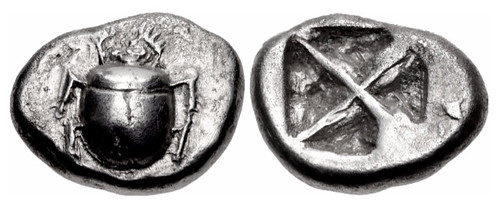 Lot 102–ATTICA, Athens.M Circa 545-525/15 BC. AR Didrachm (20.5mm, 8.35 g). “Wappenmünzen” type. Scarab beetle / Quadripartite incuse square, divided diagonally. Seltman Group B, 20 var. (A14/P– [unlisted rev. die]) = Svoronos, Monnaies, pl. 1, 38 = Traité I 1112 = Weber 3420 = Photiades Pacha Collection (Hoffmann, 19 May 1890), lot 495; HGC 4, 1612 (illustrating Weber piece). Good VF, minor roughness. Extremely rare, apparently the second known, after the Weber/Photiades Pacha piece. Estimated at $30,000 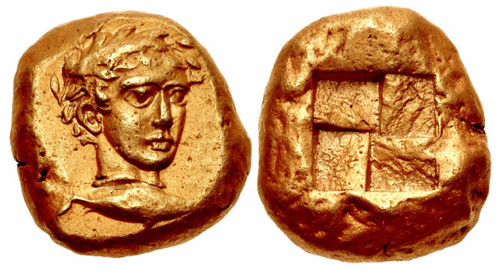 Lot 187–MYSIA, Kyzikos. Circa 450-330 BC. EL Stater (18mm, 16.09 g). Head of Apollo, wearing laurel wreath, facing slightly right; below, tunny right / Quadripartite incuse square. Von Fritze I 132; Greenwell 17; Boston MFA 1492 = Warren 1436; SNG BN 283–4; BMC 56; Gillet 1079; Gulbenkian –; Jameson –; Myrmekion 93 (same rev. punch); Prospero 460; Rosen –; Weber –. Good VF. Well centered. Among the most artistic types in the series. Estimated at $20,000 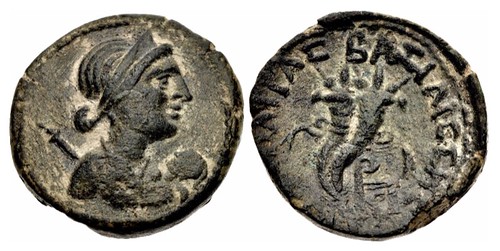 Lot 456–PTOLEMAIC KINGS of EGYPT. Kleopatra VII Thea Neotera & Ptolemy XV Caesarion. 44-30 BC. Æ (28mm, 16.86 g, 12h). Paphos mint. Struck circa 47 BC. Diademed and draped bust of Cleopatra, as Aphrodite, right; to right, small winged bust of Caesarion, as Eros, looking up at his mother; scepter to left / BAΣIΛIΣΣHΣ [KΛEOΠ]ATPAΣ, double cornucopia bound with fillet; monogram to right. Svoronos 1874; Weiser –; SNG Copenhagen –; BMC 2; Noeske –; RPC I 3901.9. Good VF, rough olive patina, a few faint cleaning scratches. Extremely rare. Estimated at $10,000 This lovely bronze type, while ostensibly displaying Aphrodite holding Eros in her arms, was in fact a dynastic issue, following in the Ptolemaic tradition that rulers were represented in the guise of gods. Here, the identification of Kleopatra as Aphrodite is not controversial, as the two are often related in classical literature. The choice of this type is relative to its place of the issue, Cyprus, where an important temple to Aphodite was located at Paphos. In 48 BC, Julius Caesar gave Cyprus to Kleopatra, and the fact that Caesarion was his son by the Egyptian queen lends credence to the identification of Eros as Caesarion on this coin. Literary and epigraphic evidence clearly displays the intent of Kleopatra to elevate their son to the status of a co-ruler, and as such, his presence on the coin would be conventional. Nonetheless, other candidates have been suggested, such as either of her sons by Mark Antony, Alexander Helios or Ptolemy Philadelphos. As the coin has no indication of date, it could have been struck later, after Kleopatra gave birth to Antony's children. Two facts, though, suggest that this isolated issue would not favor either of these children over Caesarion. In 34 BC, when Antony was celebrating his Armenian 'victory' at Alexandreia, Caesarion was given a higher status in the event than Antony's sons. Also, numismatic evidence suggests that Caesarion retained his position as primary heir until Kleopatra's death (see O. Mørkholm, "Ptolemaic Coins and Chonology" in MN 20 [1975]). It seems appropriate that this exceptional issue would have been struck in commemoration of Caesarion's birth in 47 BC, on the island that had just been given to his mother, Kleopatra, by his father, Caesar.  Lot 460–KINGS of PARTHIA. Arsakes I. 247-211 BC. AR Drachm (19mm, 4.01 g, 12h). Nisa(?) mint. Head right, wearing bashlyk / Archer (Arsakes I) seated left on backless throne, holding bow. Sellwood 1.1; A&S Type 1, 1/4 (same dies); Sunrise 234; Shore 1. VF. Rare. Estimated at $1500 From the Nisa Collection. 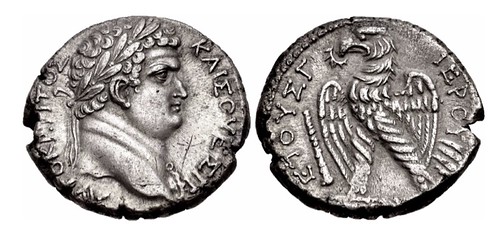 Lot 589–SELEUCIS and PIERIA, Antioch. Titus. As Caesar, AD 69- 79. AR Tetradrachm (27mm, 12.48 g, 12h). Dated “Holy Year” 3 (AD 70/1). Laureate bust right, wearing aegis / ETOYΣ Γ IEPOY, Eagle standing left on palm branch, holding wreath in beak; club to left. McAlee 379; Prieur 140; RPC II 1967. Near EF, lightly toned, a few scratches in obverse field. Fine style portrait. Estimated at $1000 The date “Holy Year” 3 coincides with the fall of Jerusalem in August of AD 70 to the Romans under Titus’ command. The portrait of Titus is similar to that seen on “Judaea Capta” bronze coins, and it is possible that these tetradrachms were struck at the same mint, probably Caesarea Maritima (see RPC II p. 276; McAlee p. 173). 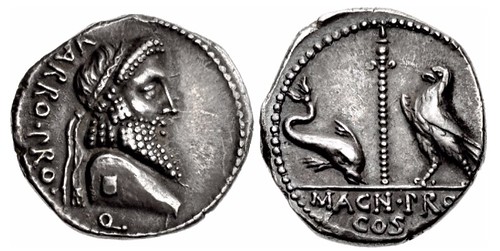 Lot 720–The Pompeians. Cnaeus Pompeius Magnus (Pompey the Great). Spring 48 BC. AR Denarius (18mm, 3.84 g, 3h). Uncertain Greek mint. Terentius Varro, pro quaestor. Diademed terminal bust of Jupiter Terminus right / Vertical scepter; to left, dolphin swimming right; to right, eagle standing left with wings folded. Crawford 447/1a; CRI 8; Sydenham 1033; RSC 3. Good VF, deep cabinet toning. Nice metal. Estimated at $1500 From the Archer M. Huntington Collection, ANS 1001.1.22847. 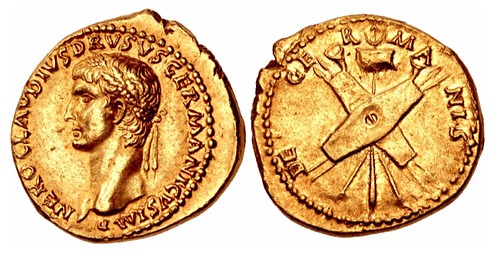 Lot 809–Nero Claudius Drusus. Died 9 BC. AV Aureus (19.5mm, 7.76 g, 1h). Lugdunum (Lyon) mint. Struck under Claudius, AD 41-42. NERO CLAVDIVS DRVSVS GERMANICVS IMP, laureate head left / DE GE R MA NIS, two oblong shields, two pairs of spears, and two trumpets, all crossed over upright vexillum. RIC I 73 (Claudius); von Kaenel Type 13 (unlisted dies); Lyon 24 (Claudius); Calicó 317; BMCRE 105-6 (Claudius); BN 8 (Claudius); Biaggi 182 (this coin). EF, lustrous. Estimated at $20,000 Ex Leo Biaggi de Blasys Collection, 182. 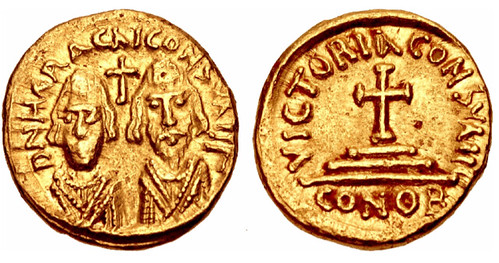 Lot 1035–Revolt of the Heraclii. 608-610. AV Solidus (16mm, 4.49 g, 6h). Carthage mint. Dated IY 13 (609/10). D N HЄRACΛI CONSVΛI IΓ, bareheaded busts of Heraclius the younger, beardless, and the exarch Heraclius, bearded, each wearing consular robes; cross above / VICTORIA CONSVΛI, cross potent set on three steps; IΓ//CONOB. DOC 3; MIBE 1; Lacam, Civilisation, pl. XXXI-A, 2 = Adams I 287 (same obv. die); SB 710. Near EF. An earlier obverse die state than the Adams specimen cited above. Extremely rare, with only the Adams example in CoinArchives. Estimated at $7500 Beginning in 608, the exarch of Africa and his son, both named Heraclius, began issuing coinage in opposition to that of the unpopular Byzantine emperor Phocas. This coinage named and depicted the Heraclii as consuls (though neither held the title at that time) rather than as emperors, a political move that promoted the Heraclii as champions of the people, not merely rivals to the throne. The revolt culminated with Heraclius the younger’s coup at Constantinople in 610, where he was welcomed by the population, crowned, and saw to the execution of his predecessor. The solidi dated to indictional year 13 constitute the final gold issue of the revolt. 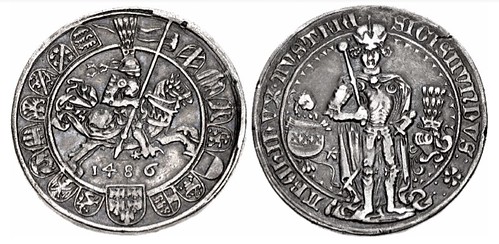 Lot 1091–AUSTRIA, Holy Roman Empire. Erzherzogtum Österreich (Archduchy of Austria). Sigismund. Archduke, 1446-1490. AR Taler (41mm, 31.66 g, 10h). Hall mint. Dated 1486. Crowned, draped, and armored figure standing facing, holding globe-tipped scepter on shoulder and hilt of sword; to left, coat-of- arms held by lion; to right, crested and crowned helmet / Knight in German Gothic armor, holding banner, on caparisoned horse galloping right; 1486 below; helmet decorated with elaborate crowned crest; coats-of- arms around. Davenport 8087; Moser & Tursky 64; Levinson IV-49a; Frey 274. VF, toned, lightly chased in fields, faint edge marks. An affordable example of the first dated taler. Estimated at $5000 Constellation of Varak/Mesha Aries the Ram 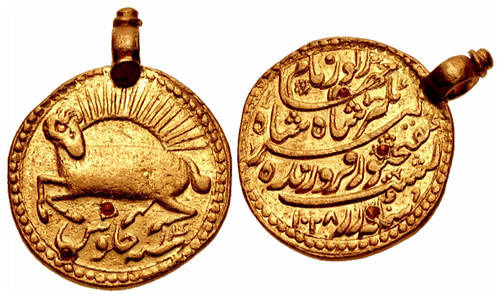 Lot 1121–INDIA, Mughal Empire. Nur al-Din Muhammad Jahangir. AH 1014-1037 / AD 1605-1627. AV Mohur (22mm, 11.86 g, 10h). Zodiac Type, Class A. Fatehpur mint. Triply dated AH 1028, RY 1[3], and RY 14 (19 December AD 1618 – 14/23 October AD 1619, but struck 20 March-20/1 April AD 1619). Constellation of Varak/Mesha (Aries the Ram): ram, head right, recumbent left; radiate sun behind; sanat 14 jalus (regnal year 14) in Persian below / sikka-e zar gist ba-Fatahpur faruzada nur-i nam Jahangir Shah Akbar Shah (Gold coin became lustrous at Fatehpur by the light of the name of Jahangir Shah [son of] Akbar Shah) in Persian verse; AH date in lower left. Liddle Type G-76 = S. Bhandare, “Important Indian coins in the Kunsthistorisches Museum, Vienna,” in ONS Journal 205 (Autumn 2010), Fig. 11 (electroype used for illustration) = KM 180.2 (illustration) = Zeno 143113 = Berlin Münzkabinett, inv. 18248179 (same rev. die); BM –; Wright –; Hull –; Nagpur –; Lucknow –; cf. Friedberg 762 (for type with no distinction to mint). Good VF, field marks, two shroff marks on obverse, three on reverse, with ornate suspension loop attached. Extremely rare, one of apparently two known. Estimated at $20,000 Ex Classical Numismatic Group 102 (18 May 2016), lot 1310. The reverse of the Berlin example, lacking the shroff marks of our coin, reveals that the die was dated RY 13 – located below the word nur and with the number 3 almost completely obliterated by a shroff mark. This die was paired with an Agra mint obverse die (cf. Triton XIX, lot 2399) to strike this extremely rare mohur. The two known examples are struck from two obverse and one reverse dies. Owing to an epidemic of plague in Agra, Jahangir encamped at Fatehpur during AH 1028 (see S.H. Hodivala, “The Chronology of the Zodiacal Coins of Jahangir”, NC 1929, p. 306). As recounted in his autobiography, the Tuzuk-e Jahangiri, Jahangir entered Fatehpur on the 28th Di, RY 13 (18 January AD 1619) and remained there until 31 Farwardin, RY 14 (20/1 April 1619). According to the Solar Hijri calendar, four zodiacal signs cover the period during which Jahangir resided in Fatehpur. The last of these, Varak/Mesha (Aries the Ram), refers to the month of Farwardin, enabling us to date this coin to that month. Given that the obverse corresponds with the month of Jahangir’s departure from Fatehpur, and the extreme rarity of this mohur type from that mint, it is quite possible that these coins were struck in conjunction with the emperor’s departure from Fatehpur, and were presented to those members of the local elite who had accommodated Jahangir during his stay. 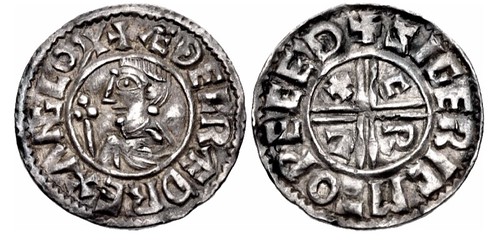 Lot 1197–ANGLO-SAXON, Kings of All England. Æthelred II. 978- 1016. AR Penny (20mm, 1.73 g, 11h). Crux type (BMC iiia, Hild. C). Watchet mint; Sigeric, moneyer. Struck circa 991-997. Draped bust left; trefoil-tipped scepter before / + SIGERIC M–O PECED, voided short cross; C R V X in angles. Blackburn, Mint 5 (dies A/a), Unseen coins (a) (this coin); SCBI 24 (West Country), 487 (same dies); North 770; SCBC 1148. VF, toned, some peck marks. Extremely rare and of considerable interest. Estimated at $2500 Ex Richard Cyril Lockett Collection (English Part I, Glendining, 6 June 1955), lot 686 (part of); Sir John Evans Collection. In his study and corpus of the Watchet mint, Mark Blackburn demonstrated that there was sudden cessation of coin production very early in the issue of the Crux type. This coin was one of only six Crux type pennies recorded, all struck from the same pair of dies. Remarkably, the reverse die would have a second life across the Irish Sea where it was used with an obverse die in the name of Sihtric Silkbeard, the Hiberno-Norse king of Dublin (SCBI 32 Ulster 9). The Anglo Saxon Chronicle records Viking raids on Watchet in circa 988 and again in 997. However, these dates are not easily reconciled with the interruption of output and the reverse die may have made its way to Dublin by another route. *************** Printed catalogs for CNG 105 are now available. To order the catalog, please call our U.S. office at (717) 390-9194. Catalogs have been mailed to customers on CNG’s active mailing list. Prospective bidders may also view the virtual catalogs at CNG 105 Virtual Catalog. The sale can be viewed online at cngcoins.com, sixbid.com, and numisbids.com. In addition to Internet & Mail Bid Sale 105, CNG will also feature over 950 lots from many of the same collections listed above in their Electronic Auction 397, closing one week later on Wednesday, 17 May 2017, from 10AM ET (U.S.). Bidding for CNG Electronic Auction 397 will begin on 26 April 2017. CNG is currently accepting consignments for future auctions sales. Please contact the firm for further details and consignment deadlines. For further details and any additional information, please contact CNG, Inc. at: Classical Numismatic Group, Inc.
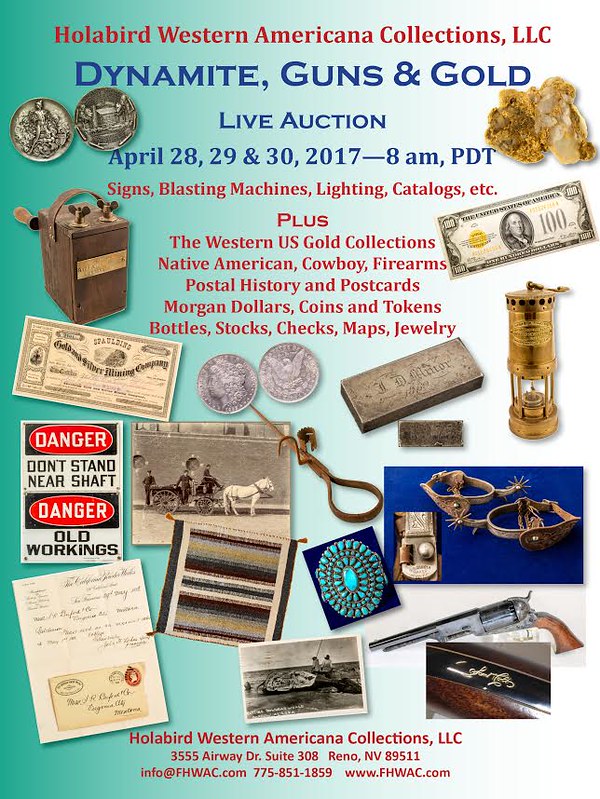 Wayne Homren, Editor The Numismatic Bibliomania Society is a non-profit organization promoting numismatic literature. See our web site at coinbooks.org. To submit items for publication in The E-Sylum, write to the Editor at this address: whomren@gmail.com To subscribe go to: https://my.binhost.com/lists/listinfo/esylum All Rights Reserved. NBS Home Page Contact the NBS webmaster 
|